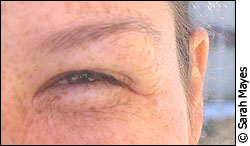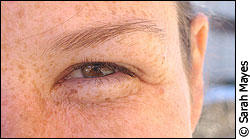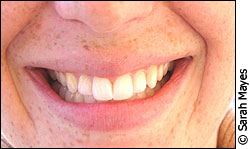| The
healing power of humour?
By Sarah Mayes
OTTAWA —
Laughter may not be the best
medicine, but humour may be. That’s the take-home
message of a recent study examining the last 45 years
of health-related humour research.
Dr. Rod Martin, a researcher at the University
of Western Ontario, reviewed all the research related
to humour and health, trying to separate fact from fiction.
He published his findings in the International Journal
of Humor Research last year. He says as it stands
now, there isn’t much solid evidence for some
of the health claims about humour.
“Basically I would say that the
idea that humour might be beneficial [to health] is
not a bad idea,” he says.
“There is research suggesting that…But
the problem is that the research so far has not been
done very well.”
Dr. Martin says the biggest problem with
humour research to date is that the experiments haven’t
been adequately controlled. The trouble is, humour is
subjective. So researchers need to ensure that their
experimental conditions are actually funny.
Martin says a common experimental design
is one where subjects watch a funny film, then are subjected
to pain. He says this should always be followed up with
a questionnaire asking subjects to give the movie a
funniness rating – something that researchers
don’t always do.
 |
| Rod Martin is a professor
of psychology at the University of Western Ontario. |
Researchers can also use documentary or
scary film conditions in their experiments, to make
sure any observed effects aren't due to distraction
or other emotions.
Despite poor scientific evidence, the
claims about humour abound: it’s purported to
“boost” the immune system, provide a natural
analgesic effect, and even promote a longer, healthier
life.
And you only have to type the words “humour”
and “health” into an Internet search engine,
and up pop a slew of related products and services:
a website for the Canadian Therapeutic Humour Association,
promos for the popular film Patch Adams, and even a
software that allows doctors to give their patients
personalized humour prescriptions. You can even become
trained as a “laughter leader.”
Self-medicating on comedy
John Gupta is one. The Montrealer has
taught an obscure brand of yoga, known as “laughter
yoga”, to over a thousand people in Canada and
US. Some of his students have been members of Gilda’s
Club, a support center for people living with cancer.
“It’s simulated laughter.
It’s laughter without jokes, and that’s
the whole idea,” he says.
Gupta says laughter yoga exercises can
be quite simple.
“It could just be greeting, like
the Indian-style greeting: you hold your palms together,
you make eye contact with people and then you go around
and you just laugh,” he says.
“And everybody just starts getting
into the action, everybody’s laughing…You
feel the energy. When people are together and laughing
together, it creates such an energy, it’s unbelievable.”
The idea that humour could have a beneficial
effect on health has been around for centuries, but
it’s also had its modern champions. Norman Cousins
was among them. Cousins was the editor of prominent
US literary magazine, The Saturday Review.
In 1964 he was diagnosed with a progressive, debilitating
inflammatory disorder that put him in constant pain.
He was given about six months to live.
As the story goes, Cousins began self-medicating
with doses of comedy: he watched repeated episodes of
Candid Camera, and Marx Brothers movies. Cousins claimed
that 10 minutes of hearty laughter would provide two
hours of pain-free sleep. He recovered from his condition,
and documented his experience in his book, Anatomy
of an Illness (1979).
Laugh your pain away?
Dr. Martin says Cousins may have been
on to something. However, Martin says the humour-longevity
claim has largely been disproved, funny people have
been shown to be no healthier than the rest of the population,
and the jury’s still out on any beneficial effects
that humour may have on the immune system. But he says
studies into the effects of humour on pain are quite
promising.
"Researchers have done some pretty
well-controlled studies, and they all pretty consistently
indicate that when people are exposed to humour they
can tolerate more pain,” he says.
Dr. Willibald Ruch, a researcher at the
University of Zurich, published one such study last
year, in the International Journal of Humor Research.
 |
| Willibald Ruch is a researcher
at the University of Zurich. |
"We wanted to look at [the analgesic
effect] in a little bit more detail,” he says.
So we looked at ‘Is it really laughter
that causes it?’ Because all of the hypotheses
that there are related to pain are tied to laughter.”
Ruch and his colleagues made 56 subjects
watch a Mr. Bean episode, then subjected them to what’s
known as a “cold pressor test.” This test
involves submerging a subject’s hand into iced
water to see how long they can tolerate it.
They divided their test subjects into
three groups: the first group was instructed to laugh
out loud in an exaggerated way, the second was told
to enjoy the film but to suppress any smiling or laughter,
and the final group was asked to produce humorous commentary
to go along with the film.
The researchers videotaped the subjects’
facial expressions and measured their pain tolerance
before, during and 20 minutes after the film.
Dr. Ruch says he was surprised by the
study’s findings.
“We found that laughter itself actually
is not really central to the [analgesic] effect. It’s
more whether people enjoy themselves or not.
Laughing as much as you can, or commenting
on the situations in a funny way didn’t make a
difference. The major difference is for the people who
showed smiling involving the eyes.”
Don't fake it


|
| A real smile produces an
unmistakeable crinkling around the eyes [top]].
A fake smile [bottom] produces less or no crinkling.
|
This “smiling with the eyes”
is also known as the “Duchenne smile”, named
after Guillaume Duchenne, a nineteenth century French
neurologist who mapped out the muscles of the human
face.
Duchenne classified facial expressions
according to the muscles used to produce them. He observed
that half-hearted or “fake” smiles only
involve the muscles around the mouth. And according
to Duchenne, a true smile involves contraction of the
muscles around the eye – the orbicularis oculi
– along with a raising of the cheek by the zygomatic
major muscle.
While Ruch found that subjects displaying
the Duchenne smile tolerated more pain, the “fakers”
didn’t fare so well.
“In our study, any voluntary effort
on facial expression, anything which people did which
was not genuine…actually reduced the [analgesic]
effect.”
Dr. Martin says that discovery is very
significant, particularly when you consider things like
laughter yoga.
“Laughter is a behaviour. It’s
an expression of emotion that conveys to other people
that we’re feeling a particular emotion. And the
emotion is the feeling of… amusement, mirth, exhilaration.
And if there are any benefits for health, it has to
do with being genuinely amused. It’s not just,
you know, laughing artificially in some bizarre way.
It’s the emotion. It’s being amused.”
No laughing matter
Dr. Pierre Rainville, an expert in pain
and emotion at the University of Montreal, is impressed
with the pain-killing effect that humour seemed to produce.
“The magnitude of the analgesic
effect is quite strong. In some cases they’ve
doubled the subject’s [pain] tolerance…
In pharmacological terms anything that would produce
that type of effect would be very clinically significant.”
Dr. Rainville says similar pain tolerance
tests are conducted with more traditional analgesics,
like morphine. In one type of test - called an ischemic
pain test - a subject’s arm is wrapped a tourniquet,
cutting off blood flow. Without any painkiller, Dr.
Rainville says subjects can tolerate this for about
10 to 15 minutes. With morphine, pain tolerance can
be increased to about 25 minutes.
| 'The magnitude
of the analgesic effect is quite strong. In some
cases they’ve doubled the subject’s
[pain] tolerance… In pharmacological terms
anything that would produce that type of effect
would be very clinically significant.' |
He says Ruch’s participants showed
a similar doubling of pain tolerance: subjects were
able to withstand having their hands submerged in ice
water for 35 seconds without the humorous film, and
that was increased up to 55 seconds after they watched.
Furthermore, the pain-killing effect seems to last.
Something that Dr. Ruch finds encouraging.
“Most studies of humour and pain
just looked at a humorous film and then looked at the
effects immediately afterwards,” Ruch says.
[But] we could still find the enhanced
pain tolerance after 20 or 30 minutes. So maybe there
are some delayed and even longer-lasting effects…So
the good thing about our study is that it might point
into a new direction.”
Ruch and his colleagues are replicating
the Mr. Bean study in hopes of getting a better understanding
of what’s needed to produce the analgesic effect.
“We have a larger sample, and…
we have a more fine-grained observation of all the facial
variables so that we can be even more precise.
So now the question will be...‘Does
[the Duchenne smile] have to have a certain intensity
or duration, or should there be an episode of smiling
of at least whatever number of minutes to observe this
effect?’… Because this would be essential
in the long run for finding a therapy, or for applying
[this finding].”
But how the body produces this pain-killing
effect is still unknown, although Dr. Martin says there
is speculation.
“The hypothesis is that it’s
due to endorphins being produced in the brain. And I
think that’s a likely hypothesis…But it’s
never actually been demonstrated. So we still need to
do some research to see whether the effect is mediated
by endorphins.”
Locking out pain
Endorphins are the body’s own natural
analgesics. They bind to special receptors on nerve
fibers, known as opiate receptors, which moderate pain
messages heading for the central nervous system and
brain.
Receptors are like a lock: only a special
key will fit them properly. Like endorphins, certain
types of narcotics – like morphine, heroin, methadone
and opium – will also fit the opiate receptor
“lock”. And like endorphins, they are also
effective painkillers.
But other substances can be used to “jam”
these receptor-locks, and prevent the key-like substances
from binding. In the case of opiate receptors, a drug
called naloxone has just that effect. Dr. Martin says
naloxone could be useful in determining if endorphins
are involved in humour’s apparent pain-killing
effect.
 |
| Fakin' it: fake smiles like
this one only use muscles around the mouth, not
the eyes. |
“What you do is, you give some participants
naloxone and you have other participants that don’t
have the drug. And you have them watch a comedy film
and you see whether their pain tolerance increases after
the film.
The people who had the naloxone…if
their pain tolerance does not increase, then that indicates
that it’s probably endorphins that are the mediator
of the effect.”
But Dr. Rainville says there are other
natural analgesics that could be responsible.
“Endorphins are often used to explain
any pain modulating effect…But there are several
other systems that might be involved. For example, there
are pain-modulating conditions where we know that…endorphins
are not necessary.”
Dr. Rainville points to studies on the
pain-killing effects of hypnosis. Subjects that are
hypnotized, then exposed to a cold pressor test, will
show higher pain tolerance than non-hypnotized subjects.
Surprisingly, subjects that are hypnotized and given
naloxone will still show high pain tolerance. This suggests
that another substance – one that doesn’t
bind to opiate receptors – is involved.
In the case of humour-mediated pain relief,
Dr. Rainville suggests a number of potential chemical
candidates that the body produces.
“Serotonin, for one, because we
know that there are nerve fibres that leave parts of
the brainstem and control incoming pain signals. And
those nerves communicate using the neurotransmitter
serotonin."
Then there’s dopamine – another
neurotransmitter that’s involved in reward-related
pain relief. And then there are the endogenous cannabinoids.
They act like THC, [the active ingredient] in marijuana.”
Dr. Ruch says after replicating the Mr.
Bean study, the next step will be to identify what’s
happening at a biochemical level.
“But for now, the best would be
just to let people enjoy themselves, not really force
them into laughter. Just to let people express their
way of how they show positive emotions. Whether they
habitually do more smiling or laughter, or whatever,
rather than tell them to laugh as much and as loud,
and as hard and long as possible.”
But John Gupta still maintains there are
benefits to faking laughter.
“You fake it ‘til you make
it. That’s the whole idea,” he says.
Nevertheless, he says sooner or later
his students become genuinely amused with the laughter
yoga exercises he teaches, and that means they could
benefit from any pain-killing effect that humour may
provide.
“After awhile…they don’t
fake it anymore. It becomes natural. People realize
that it is doing them good. And one thing that I have
never heard is somebody that went from my session and
said ‘Oh my gosh, laughter makes you feel bad.’
I’ve never heard that yet.”
|